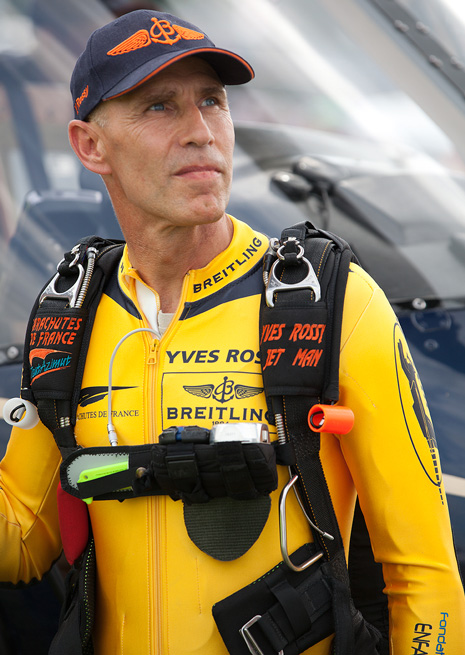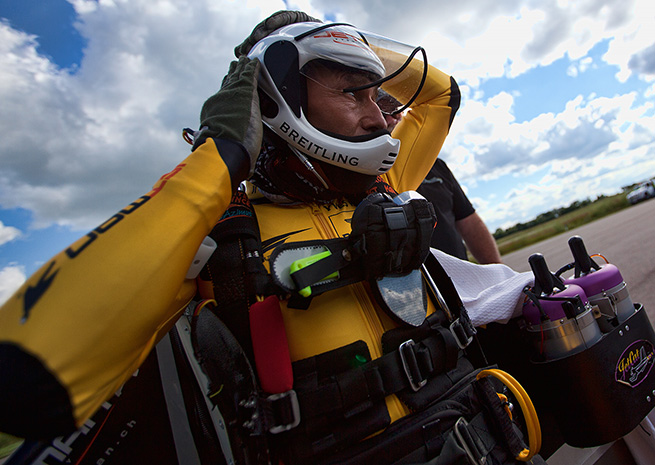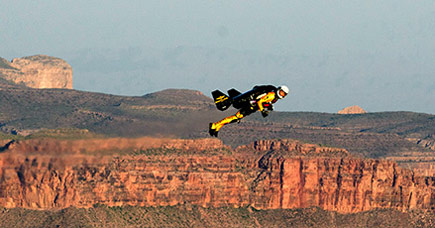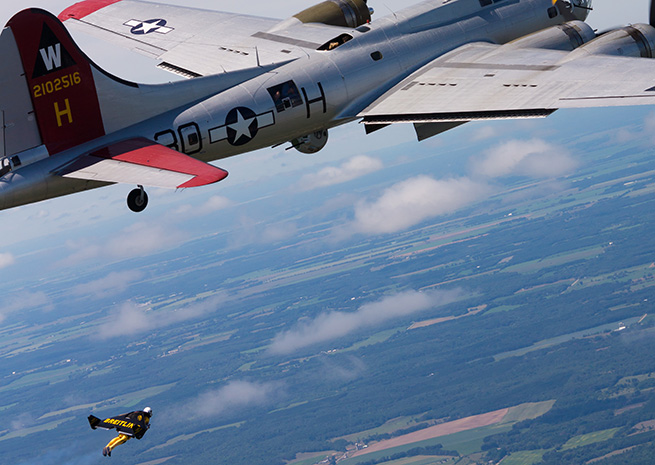Born to fly like a bird
Yves Rossy opens up to pilots about his journey to become Jetman
Suspended upside down by his feet from a skysurfing wing attached to a hoist, Yves Rossy wiggled and twisted, struggling to break free from bindings without using his hands. It wasn’t a Houdini stunt, but a test of a life-saving escape move in case he lost control of the wing in the air. Rossy fell head first a few feet to the ground, satisfied.
In a wide-ranging presentation, Rossy, 54, shared that and other behind-the-scenes videos and stories of his journey to become Jetman with EAA AirVenture attendees Au g. 1 during a Theater in the Woods event in Oshkosh, Wis. Rossy detailed his early attempts at skydiving, using a wingsuit, sky surfing, and experimenting with different types of on-the-back wings; he also opened up about struggles with his ego and how failures have ultimately led to his success. Of particular interest to EAA AirVenture attendees was his struggle with the FAA to be allowed to fly in the United States.
Rossy reassured the crowd that what some would call death-defying feats were instead research aimed at saving his life in case something went wrong during one of his quests to fly free like a bird.
That research—and an important lesson he carries with him from his background as a pilot to always have an out—has saved his life more than once.
Making of Jetman

Since he was a child, Rossy had a dream to fly. He became a fighter pilot and an airline pilot. But he wanted more.
“The idea was to come back to the roots, to the idea (of flying like a bird),” Rossy said.
Skydiving offered him 45 seconds of flying free with “only a little parachute on your back,” he explained. That’s when he decided to try to extend such flights. In the mid-1990s, Rossy started skysurfing, a type of skydiving where one stands on a board, after researching others’ strategies. He later began adapting the board to a winglike shape.
He tried wingsuits, but they had limitations as well, he said: Holding the suit open for long periods of time was tiring. Plus, he didn’t like feeling as if he were “in a sleeping bag. You aren’t free in your movement.”
Then, he researched wings mounted on his back.
He tested a harness that would allow him to separate from the wing, one parachute for himself and another for the wing. “If you have something on your back, you should have a harness, you should have a Plan B in case something goes wrong,” he said.
Jumping with a combination rigid/inflatable wing (rigid in the middle with ends that inflated after he jumped from the airplane) improved his glide ratio: “For each meter I did lose vertically, I did four meters forward.”
Overcoming fear, failure
Rossy modified the wing more, adding two small JetCat engines and electric ailerons, and achieved level flight in 2003.
“With that wing, I could only do six minutes of flight,” he said. Still, it was a vast improvement over his 45-seconds of flight less than a decade earlier.
To this point, Rossy, then an airline captain, had funded all of his work himself. “All this did cost a lot, I was my own sponsor,” he said, adding that he had a nice salary that allowed him to do so. “Instead of buying a nice car every two years,” he said all of his money went into his quest to fly like a bird.
In 2005, Rossy traveled to Abu Dhabi to participate in the Al Ain Aerobatic Show in hopes of securing a sponsor. But, during a training jump before the show, he had to detach from the wing; despite the wing’s parachute deploying, it was damaged and prevented him from flying.
“You go over there, full of hope you will find support,” he said expressing his devastation. “You are aircraft builders, and you have the same experience in the garage—sometimes it works, and sometimes it doesn’t.”
After that, Rossy decided he wanted to be able to climb. He changed the wingtip aerodynamics. During a test flight he rolled onto his back and had to break free. At that point, he said he experienced fear. “Hey, I will kill myself. I will kill myself,” he thought.
The passion to fly like a bird was still there, but “I did need a break.”
“We have a very big, great capacity to forget and keep the good things near and the bad away. So, I had that capacity,” he said, laughing as he explained the process of rebuilding and testing the wing. (He also showed dramatic footage of a bad landing he had to recover from after tumbling head over heels with the wing still attached.) He filmed his flights to analyze what was going wrong, and when. From the footage, he spotted the problem: The hinge on one side of the rigid wing moved, causing the instability.
Achieving the dream

With a more stable wing and increased power (he added two more engines for a total of four), Rossy jumped again—and flew as he had dreamed of since childhood. The aircraft he jumped from joined up with him in formation, and he could climb and descend. “That was like in the dream,” he said. “It was completely unreal.”
“To climb is just arching back,” he said, demonstrating the small movement and explaining that once he reached the appropriate climb angle, he returned to his original position. He could climb at more than 30 degrees.
“That’s for these moments that I do that, that we do that,” he said. “I’m the only one under the wing, but I had so many friends participate. It was really great to share that with them.”
He posted videos of the flight on YouTube, and soon traffic to his website increased exponentially. “From this point, finally I could get sponsors,” he said.
When ego gets in the way
With a sponsor and international attention, along with a request from National Geographic to feature him, Rossy faced new pressures, including reining in his own ego.
National Geographic wanted Rossy to fly across the English Channel in 2008. He would need to fly more than 20 miles over cold water and would approach the limits of his range. Quickly changing weather conditions presented another challenge, along with the pressures of a film crew on each side of the channel and an aircraft flying overhead to provide a satellite feed.
“During the preparation, I was completely in ego,” Rossy admitted. “I was nervous, angry, not so friendly with my friend. It was ego driven.”
Bad weather forced Rossy to cancel the flight that day, and his friends took the opportunity to talk to him that night. “Thanks [to] this bad weather, we did discuss this in the evening.” His friends said, “Don’t go alone, take us with you,” Rossy recalled. The next morning, he had a better attitude and crossed the channel.
“I did cross the channel with really everybody holding me in the air,” he said. Now, he keeps his friends and team in mind when achieving a new feat. During the Theater in the Woods presentation, he introduced and thanked the team members present, acknowledging he can’t do it alone.
Rossy also admitted that his first marriage ended because he was wrapped up in his ego.
“You learn, each step of your life,” he explained. “I put the priority at the wrong commitment.” Now, he said, his wife is No. 1 in his life. “And she’s my best supporter.”
In addition to checking his ego, Rossy also learned that he had to carefully examine his mental and physical state before each flight. “I am the fuselage,” Rossy said, explaining the difference between flying a wing and flying an aircraft. “If I am not so good in my head or my body, it doesn’t fly well. If I am completely under tension, it doesn’t fly well.”
A sponsor wanted him to cross the Strait of Gibraltar for an intercontinental flight from Africa to Europe. A small cloud layer formed the day of the flight, but Rossy climbed above the layer. However, he encountered turbulence over the cloud, causing him to descend into it.
“So, I’m not IFR!” he exclaimed. He popped out of the cloud with a vertical descent of about 160 mph and was forced to break free of the wing.
“This is my wing in the middle of Gibraltar,” he said as he pulled up a picture. “It’s still there because they couldn’t find it. But they did find me. Plan C did work.”
As he did after each previous failed attempt or crashed wing, Rossy went back to testing. This time, he also secured a donor and used a sophisticated wind tunnel to measure the airflow over the wing. The wing was unstable in yaw and roll.
“They said this thing shouldn’t fly,” he said. Rossy, however, saw this as a positive discovery. He had successfully crossed the English Channel with something that shouldn’t be able to fly. Just think of what he could do with a wing that was stable.
He refined the design again and has used the same wing profile for the last four years, only adjusting the four engines. The wing holds 7.5 gallons of fuel, giving him 10 minutes to fly. He’s also experimenting on some flights with a pyrotechnic parachute that will allow him to fly lower before pulling the chute. The pyrotechnic parachute would work safely even if he had to deploy it in the event of an engine failure, turned on his back, at low altitude.
Battling the FAA
When Rossy’s next feat—overflying the Grand Canyon—brought him to the United States, he faced a different obstacle: the FAA. The agency said he needed to register his wing as an aircraft and receive many exemptions.
“I have no transponder, I have no radio, I have no nothing,” Rossy said, adding that he has a timer for fuel and an altimeter with an alarm that sounds at his minimum altitude. “It was a fight, a paper fight.”
Rossy canceled his Grand Canyon overflight moments before launch with dozens of media outlets present. Some may have thought it was a publicity stunt, but Rossy said it was a move—the right move, he emphasized—in favor of safety. He received permission for the flight from the FAA just 20 minutes before he was scheduled to fly, leaving him no time to practice. He had never flown with the helicopter pilot who would be carrying him aloft, and he had never flown over the canyon with its unique wind currents. He had been focused on the paperwork, not the training.
“That was the right decision,” he said of canceling. “If you have a bad gut feeling, it’s don’t go.”
He successfully flew over the canyon the following day without media present. “That was absolutely fantastic, just one with nature,” he said.
Rossy has also flown around Christ the Redeemer in Rio de Janeiro. “To land on Copacabana, it’s not every day!” He’s flown formation with a DC-3, wingwalkers, and L-39s. But he isn’t done yet. Now, Rossy is training a student Jetman and hopes to one day open a school to train others to fly like a bird.
“Hold onto your dreams, it’s worth [it],” he said. “It’s fantastic.”




